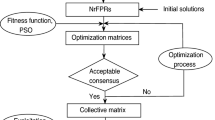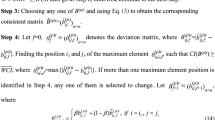Abstract
Reciprocal fuzzy preference relation (FPR) is a hot topic in the research field of group decision making (GDM). Within the framework of GDM, a two-stage consensus reaching model is proposed to modify the decision makers’ (DMs’) FPRs. In the first stage which is called consistency improving stage, a consistency index and an iterative algorithm are employed to measure and improve individual consistency, respectively. In each iteration of the algorithm, only one pair of preference values, which deviates the most from the corresponding elements in the consistent FPR matrix, are modified to keep the DM’s original information as much as possible. In the second stage which is called consensus reaching stage, individual consensus index and group consensus index are applied to measure consensus. A convex quadratic programming model is developed to help DMs reach consensus. Some desired properties of the model are also investigated and testified. What’s more, the final individual consistency is also limited to an acceptable threshold. Finally, a practical example is used to illustrate the validity of the proposed consensus model.



Similar content being viewed by others
Explore related subjects
Discover the latest articles, news and stories from top researchers in related subjects.References
Alonso S, Herrera-Viedma E, Chiclana F, Herrera F (2010) A web based consensus support system for group decision making problems and incomplete preferences. Inf Sci 180:4477–4495
Cabrerizo FJ, Moreno JM, Pérez IJ, Herrera-Viedma E (2010) Analyzing consensus approaches in fuzzy group decision making: advantages and drawbacks. Soft Comput 14:451–463
Cabrerizo FJ, Herrera-Viedma E, Pedrycz W (2013) A method based on PSO and granular computing of linguistic information to solve group decision making problems defined in heterogeneous contexts. Eur J Oper Res 230:624–633
Cabrerizo FJ, Ureña R, Pedrycz W, Herrera-Viedma E (2014) Building consensus in group decision making with an allocation of information granularity. Fuzzy Sets Syst 255:115–127
Cabrerizo FJ, Al-Hmouz R, Morfeq A, Balamash AS, Martínez M, Herrera-Viedma E (2017) Soft consensus measures in group decision making using unbalanced fuzzy linguistic information. Soft Comput 21:3037–3050
Cabrerizo FJ, Morente-Molinera JA, Pedrycz W, Taghavi A, Herrera-Viedma E (2018) Granulating linguistic information in decision making under consensus and consistency. Expert Syst Appl 99:83–92
Chiclana F, Herrera F, Herrera-Viedma E (1998) Integrating three representation models in fuzzy multipurpose decision making based on fuzzy preference relations. Fuzzy Sets Syst 97:33–48
Chiclana F, Herrera-Viedma E, Herrera F, Alonso S (2007) Some induced ordered weighted averaging operators and their use for solving group decision-making problems based on fuzzy preference relations. Eur J Oper Res 182:383–399
Chiclana F, García JM, Moral MJ, Herrera-Viedma E (2013) A statistical comparative study of different similarity measures of consensus in group decision making. Inf Sci 221:110–123
del Moral MJ, Chiclana F, Tapia JM, Herrera-Viedma E (2018) A comparative study on consensus measures in group decision making. Int J Intell Syst 33:1624–1638
Dong YC, Xu YF, Li HY, Feng B (2010a) The OWA-based consensus operator under linguistic representation models using position indexes. Eur J Oper Res 203:455–463
Dong YC, Zhang GQ, Hong WC, Xu JP (2010b) Consensus models for AHP group decision making under row geometric mean prioritization method. Decis Support Syst 49:281–289
Dong YC, Zha QB, Zhang HJ, Kou G, Fujita H, Chiclana F, Herrera-Viedma E (2018a) Consensus reaching in social network group decision making: research paradigms and challenges. Knowl Based Syst. https://doi.org/10.1016/j.knosys.2018.06.036
Dong YC, Zhao SH, Zhang HJ, Chiclana F, Herrera-Viedma E (2018b) A self-management mechanism for non-cooperative behaviors in large-scale group consensus reaching processes. IEEE Trans Fuzzy Syst. https://doi.org/10.1109/TFUZZ.2018.2818078
Herrera F, Herrera-Viedma E, Verdegay JL (1996a) A model of consensus in group decision making under linguistic assessments. Fuzzy Sets Syst 78:73–87
Herrera F, Herrera-Viedma E, Verdegay JL (1996b) A rational consensus model in group decision making using linguistic assessments. Fuzzy Sets Syst 88:31–49
Herrera-Viedma E, Herrera F, Chiclana F (2002) A consensus model for multiperson decision making with different preference structures. IEEE Trans Syst Man Cybern Part A Syst Hum 32:394–402
Herrera-Viedma E, Herrera F, Chiclana F, Luque M (2004) Some issues on consistency of fuzzy preference relations. Eur J Oper Res 154:98–109
Herrera-Viedma E, Martinez L, Mata F, Chiclana F (2005) A consensus support system model for group decision-making problems with multigranular linguistic preference relations. IEEE Trans Fuzzy Syst 13:644–658
Herrera-Viedma E, Alonso S, Chiclana F, Herrera F (2007) A consensus model for group decision making with incomplete fuzzy Preference Relations. IEEE Trans Fuzzy Syst 15:863–877
Kacprzyk J (1986) Group decision making with a fuzzy linguistic majority. Fuzzy Sets Syst 18:105–118
Liu WQ, Dong YC, Chiclana F, Cabrerizo FJ, Herrera-Viedma E (2017) Group decision-making based on heterogeneous preference relations with self-confidence. Fuzzy Optim Decis Mak 16:429–447
Ma J, Fan ZP, Jiang YP, Mao JY, Ma L (2006) A method for repairing the inconsistency of fuzzy preference relations. Fuzzy Sets Syst 157:20–33
Önüt S, Efendigil T, Kara SS (2010) A combined fuzzy MCDM approach for selecting shopping center site: an example from Istanbul, Turkey. Expert Syst Appl 37:1973–1980
Orlovsky SA (1978) Decision-making with a fuzzy preference relation. Fuzzy Sets Syst 1:155–167
Pérez IJ, Cabrerizo FJ, Alonso S, Dong YC, Chiclana F, Herrera-Viedma E (2018) On dynamic consensus processes in group decision making problems. Inf Sci 459:20–35
Roubens M (1997) Fuzzy sets and decision analysis. Fuzzy Sets Syst 90:199–206
Saaty TL (1980) The analytic hierarchy process. McGraw-Hill, New York
Tanino T (1984) Fuzzy preference orderings in group decision making. Fuzzy Sets Syst 33:117–131
Wu J, Chiclana F (2014) Visual information feedback mechanism and attitudinal prioritisation method for group decision making with triangular fuzzy complementary preference relations. Inf Sci 279:716–734
Wu ZB, Xu JP (2012) A concise consensus support model for group decision making with reciprocal preference relations based on deviation measures. Fuzzy Sets Syst 206:58–73
Xu ZS, Cai XQ (2011) Group consensus algorithms based on preference relations. Inf Sci 181:150–162
Xu YJ, Da QL, Liu LH (2009) Normalizing rank aggregation method for priority of a fuzzy preference relation and its effectiveness. Int J Approx Reason 50:1287–1297
Xu YJ, Li KW, Wang HM (2013) Distance-based consensus models for fuzzy and multiplicative preference relations. Inf Sci 253:56–73
Xu YJ, Gupta JND, Wang HM (2014) The ordinal consistency of an incomplete reciprocal preference relation. Fuzzy Sets Syst 246:62–77
Xu YJ, Chen L, Rodríguez RM, Herrera F, Wang HM (2016) Deriving the priority weights from incomplete hesitant fuzzy preference relations in group decision making. Knowl Based Syst 99:71–78
Xu YJ, Cabrerizo FJ, Herrera-Viedma E (2017) A consensus model for hesitant fuzzy preference relations and its application in water allocation management. Appl Soft Comput 58:265–284
Xu YJ, Liu X, Wang HM (2018a) The additive consistency measure of fuzzy reciprocal preference relations. Int J Mach Learn Cybern 9:1141–1152
Xu YJ, Wang QQ, Cabrerizo FJ, Herrera-Viedma E (2018b) Methods to improve the ordinal and multiplicative consistency for reciprocal preference relations. Appl Soft Comput 67:479–493
Yager RR (1988) On ordered weighted averaging aggregation operators in multicriteria decisionmaking. IEEE Trans Syst Man Cybern 18:183–190
Zadeh LA (1983) A computational approach to fuzzy quantifiers in natural languages. Comput Math Appl 9:149–184
Zhang BW, Dong YC, Xu JP (2014) Multiple attribute consensus rules with minimum adjustments to support consensus reaching. Knowl Based Syst 67:35–48
Zhang HJ, Dong YC, Herrera-Viedma E (2017) Consensus building for the heterogeneous large-scale GDM with the individual concerns and satisfactions. IEEE Trans Fuzzy Syst 26:884–898
Acknowledgements
The authors are very grateful to associate editor and the anonymous reviewers for their constructive comments and suggestions that have helped to improve the quality of this paper. This work was partly supported by the National Natural Science Foundation of China (NSFC) under Grants (No. 71471056), Qing Lan Project of Jiangsu Province.
Author information
Authors and Affiliations
Corresponding author
Ethics declarations
Conflict of interest
The authors declare that they have no conflict of interest.
Additional information
Communicated by V. Loia.
Rights and permissions
About this article
Cite this article
Xu, Y., Wu, N. A two-stage consensus reaching model for group decision making with reciprocal fuzzy preference relations. Soft Comput 23, 8057–8073 (2019). https://doi.org/10.1007/s00500-018-3442-0
Published:
Issue Date:
DOI: https://doi.org/10.1007/s00500-018-3442-0




